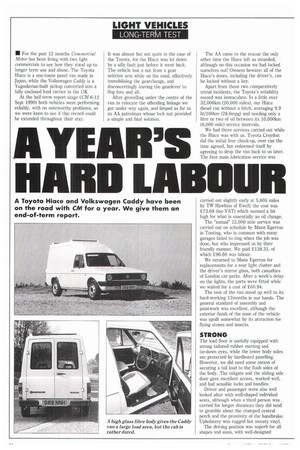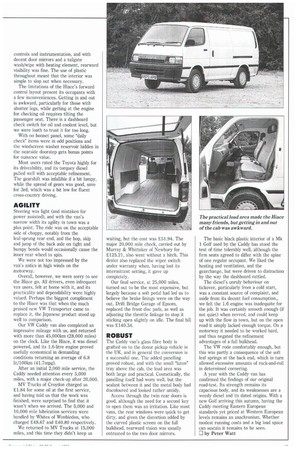A Y1EA RD LABOUR
Page 36

Page 37

If you've noticed an error in this article please click here to report it so we can fix it.
A Toyota Hiace and Volkswagen Caddy have been on the road with CM for a year. We give them an end-of-term report.
• For the past 12 months Commercial Motor has been living with two light commercials to see how they stand up to longer term use and abuse. The Toyota Hiace is a one-tonne panel van made in Japan, while the Volkswagen Caddy is a Yugoslavian-built pickup converted into a fully enclosed load carrier in the UK.
At the half-term report stage (CM 6-12 Sept 1990) both vehicles were performing reliably, with no noteworthy problems, so we were keen to see if this record could be extended throughout their stay. It was almost but not quite in the case of the Toyota, for the Hiace was let down by a silly fault just before it went back. The vehicle lost a nut from a gear selector arm while on the road, effectively immobilising the gearchange, and disconcertingly leaving the gearlever to flop fore and aft.
After grovelling under the centre of the van to relocate the offending linkage we got under way again, and limped as far as an AA patrolman whose lock nut provided a simple and final solution. The AA came to the rescue the only other time the Hiace left us stranded, although on this occasion we had locked ourselves out! Owners beware: all of the Hiace's doors, including the driver's, can be locked without a key.
Apart from these two comparatively trivial incidents, the Toyota's reliability record was immaculate. In a little over 32,000km (20,000 miles), our Hiace diesel ran without a hitch, averaging 9.9 lit/100km (28.6mpg) and needing only a litre or two of oil between its 10,000km (6,000 mile) service intervals.
We had three services carried out while the Hiace was with us. Toyota Croydon did the initial free check-up, over ran the time agreed, but redeemed itself by agreeing to drop the van back to us later. The first main lubrication service was carried out slightly early at 5,605 miles by TW Hawkins of Ewell; the cost was £73.68 (inc-VAT) which seemed a bit high for what is essentially an oil change.
The "annual" 12,000 mile service was carried out on schedule by Mann Egerton in Tooting, who in common with many garages failed to ring when the job was done, but who impressed us by their friendly manner. We paid £138.31, of which £96.60 was labour.
We returned to Mann Egerton for replacements for a rear light cluster and the driver's mirror glass, both casualties of London car parks. After a week's delay on the lights, the parts were fitted while we waited for a cost of £60.94.
The rest of the van stood up well to its hard-working 12months in our hands. The general standard of assembly and paintwork was excellent, although the exterior finish of the nose of the vehicle was spoilt somewhat by its attraction for flying stones and insects.
STRONG
The load floor is usefully equipped with strong tailored rubber matting and tie-down eyes, while the lower body sides are protected by hardboard panelling. However, we did need some means of securing a tall load to the flush sides of the body. The tailgate and the sliding side door gave excellent access, worked well, and had sensible locks and handles.
Driver and passenger were also well looked after with well-shaped individual seats, although when a third person was carried for longer distances they did tend to grumble about the cramped central perch and the proximity of the handbrake. Upholstery was rugged but sweaty vinyl.
The driving position was superb for all shapes and sizes, with well-designed controls and instrumentation, and with decent door mirrors and a tailgate wash/wipe with heating element, rearward visibility was fine. The use of plastic throughout meant that the interior was simple to slop out when necessary.
The limitations of the Hiace's forward control layout present its occupants with a few inconveniences. Getting in and out is awkward, particularly for those with shorter legs, while getting at the engine for checking oil requires tilting the passenger seat. There is a dashboard check switch for oil and coolant level, but we were loath to trust it for too long.
With no bonnet panel, some "daily check!' items were in odd positions and the windscreen washer reservoir hidden in the nearside doorstep gets bonus points for nuisance value.
Most users rated the Toyota highly for its driveability, and its torquey diesel pulled well with acceptable refinement. The gearshift was infallible if a bit lumpy, while the spread of gears was good, save for 3rd, which was a bit low for fluent cross-country driving.
AGILITY
Steering was light (and mistaken for power assisted), and with the van's narrow width its agility in town was a plus point. The ride was on the acceptable side of choppy, notably from the leaf-sprung rear end, and the hop, skip and jump of the back axle on tight and bumpy bends would occasionally cause the inner rear wheel to spin.
We were not too impressed by the van's antics in high winds on the motorway.
Overall, however, we were sorry to see the Hiace go. All drivers, even infrequent van users, felt at home with it, and its practicality and dependability were highly valued. Perhaps the biggest compliment to the Hiace was that when the much praised new VW Transporter came to replace it, the Japanese product stood up well to comparison.
Our VW Caddy van also completed an impressive mileage with us, and returned with more than 45,000km (28,000 miles) on the clock. Like the Hiace, it was diesel powered, and its 1.6-litre engine proved usefully economical in demanding conditions returning an average of 6.8 lit/100km (41.7mpg).
After an initial 2,000 mile service, the Caddy needed attention every 5,000 miles, with a major check-up after 20,000.
MV Trucks of Croydon charged us £1.84 for some oil at the first service, and having told us that the work was finished, were surprised to find that it wasn't when we arrived. The 5,000 and 10,000 mile lubrication services were handled by Whites of Wimbledon, who charged £48.67 and £40.80 respectively.
We returned to MV Trucks at 15,000 miles, and this time they didn't keep us waiting, but the cost was £51.94. The major 20,000 mile check, carried out by Murray & Whittaker of Newbury for £125.21, also went without a hitch. This dealer also replaced the wiper switch under warranty when, having lost its intermittent setting, it gave up completely,
Our final service, at 25,000 miles, turned out to be the most expensive, but largely because a soft pedal had led us to believe the brake linings were on the way out. Drift Bridge Garage of Epsom, replaced the front disc pads, as well as adjusting the throttle linkage to stop it sticking open slightly on idle. The final bill was £140.34.
ROBUST
The Caddy van's glass fibre body is grafted on to the donor pickup vehicle in the UK, and in general the conversion is a successful one. The added panelling proved robust, and with the small "Iuton" tray above the cab, the load area was both large and practical. Cosmetically, the panelling itself had worn well, but the sealant between it and the metal body had discoloured and looked rather untidy.
Access through the twin rear doors is good, although the need for a second key to open them was an irritation, Like most vans, the rear windows were quick to get dirty, and given the distortion added by the curved plastic screen on the full bulkhead, rearward vision was usually entrusted to the two door mirrors. The basic black plastic interior of a Mk 1 Golf used by the Caddy has stood the test of time tolerably well, although the firm seats agreed to differ with the spine of one regular occupant. We liked the heating and ventilation, and the gearchange, but were driven to distraction by the way the dashboard rattled.
The diesel's unruly behaviour on tickover, particularly from a cold start, was a constant source of complaint, and aside from its decent fuel consumption„ we felt the 1.6 engine was inadequate for the job. It was certainly smooth enough (if not quiet) when revved, and could keep up with the flow in town, but on the open road it simply lacked enough torque. On a motorway it needed to be worked hard, and thus negated the refinement advantages of a full bulkhead.
The VW rode comfortably enough, but this was partly a consequence of the soft leaf springs at the back end, which in turn allowed excessive amounts of rock-and-roll in determined cornering.
A year with the Caddy van has confirmed the findings of our original road-test. Its strength remains its capacious body, and its weaknesses are a weedy diesel and its dated origins. With a new Golf arriving this autumn, having the Caddy meeting Eastern European standards yet priced at Western European levels remains an anachronism. Whether modest running costs and a big load space can sustain it remains to be seen. El by Peter Watt












































































